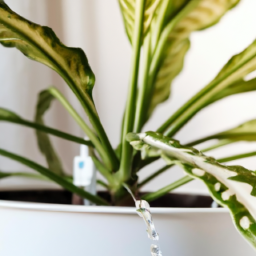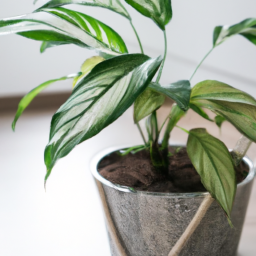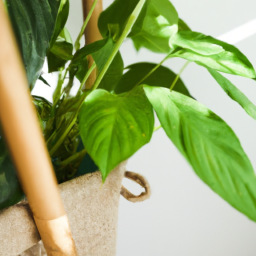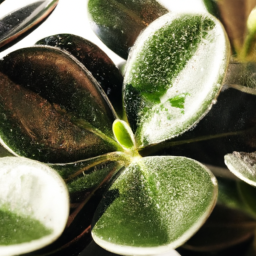
Are indoor plants healthy? This is a question that many people ask themselves when considering adding some greenery to their homes. Indoor plants have become increasingly popular in recent years, with more and more people recognizing the benefits they can bring to our overall well-being. From improving air quality to reducing stress levels, indoor plants have been praised for their ability to enhance our living spaces. In this blog post, we will explore the various ways in which indoor plants can contribute to a healthier and happier lifestyle. So, if you’ve ever wondered about the health benefits of indoor plants, keep reading to discover why they are more than just a beautiful addition to your home decor.
Benefits of Indoor Plants for Health and Well-being
Indoor plants have become increasingly popular in recent years, and for good reason. Not only do they add a touch of nature and beauty to our homes and offices, but they also offer a wide range of health benefits. In this article, we will explore the numerous ways indoor plants can positively impact our well-being and overall health.
Reduced Stress and Improved Mental Health
One of the most significant benefits of indoor plants is their ability to reduce stress and improve mental health. Research has shown that being around plants can lower blood pressure and heart rate, leading to a more relaxed state of mind. The presence of indoor plants can also help to reduce anxiety and improve overall mood.
Furthermore, indoor plants have been found to increase productivity and concentration levels. Studies have shown that having plants in the workplace can enhance cognitive function and memory retention. This can be particularly beneficial for individuals who work long hours or in high-stress environments.
In addition to reducing stress, indoor plants can also improve air quality, which has a direct impact on our mental well-being. They act as natural air purifiers by absorbing harmful pollutants and releasing oxygen. This can help to combat symptoms of poor air quality, such as headaches, fatigue, and respiratory issues.
Enhanced Physical Health
Indoor plants not only benefit our mental health but also contribute to our physical well-being. One of the primary ways they do this is by improving indoor air quality. Many common indoor plants have the ability to filter out toxins and pollutants, such as formaldehyde and benzene, which are commonly found in household items and cleaning products.
By removing these harmful substances from the air, indoor plants can help to prevent respiratory problems and allergies. They can also reduce the risk of developing conditions such as asthma and other respiratory illnesses. Additionally, indoor plants have been shown to increase humidity levels, which can alleviate dry skin, sore throats, and respiratory irritation.
Moreover, being around indoor plants has been linked to a strengthened immune system. The natural compounds released by plants, known as phytoncides, have antimicrobial properties that can help to ward off illnesses and boost our immune response. This can result in fewer sick days and an overall improvement in our physical health.
Improved Sleep Quality
Another significant benefit of indoor plants is their ability to improve sleep quality. Many plants release oxygen at night, making them ideal companions for the bedroom. This increased oxygen supply can help to promote better sleep by reducing the risk of sleep disorders, such as insomnia and sleep apnea.
Furthermore, indoor plants can create a calming and soothing environment, which is essential for achieving a restful night’s sleep. Their presence can help to lower stress levels and create a sense of tranquility in the bedroom. This is particularly beneficial for individuals who struggle with anxiety or have difficulty falling asleep.
It is important to note that not all plants are suitable for the bedroom, as some may release carbon dioxide at night. It is recommended to choose plants such as aloe vera, snake plant, or lavender, which release oxygen and have relaxing properties.
In conclusion, indoor plants offer a multitude of health benefits for both our physical and mental well-being. From reducing stress and improving air quality to enhancing sleep quality, these green companions have a significant positive impact on our overall health. So why not bring a touch of nature indoors and experience the numerous benefits that indoor plants have to offer?

Are Indoor Plants Healthy?
Indoor plants not only add a touch of beauty to our homes and offices but also offer several health benefits. They can improve air quality, reduce stress levels, and boost productivity. However, choosing and caring for healthy indoor plants requires some knowledge and effort. In this article, we will provide you with a step-by-step guide on how to choose and care for healthy indoor plants.
Tips for Choosing Healthy Indoor Plants
1. Assess the Lighting Conditions
Before selecting indoor plants, it is crucial to evaluate the lighting conditions in your space. Different plants have varying light requirements, and placing a plant in an environment with inadequate light can lead to poor growth or even death. Consider the natural light available in the room and choose plants accordingly.
If you have a well-lit area, you can opt for plants that require bright, direct sunlight. On the other hand, if your space has limited natural light, look for plants that thrive in low-light conditions, such as snake plants or pothos.
It’s important to note that some plants can tolerate a range of lighting conditions, making them versatile options for various spaces. Examples include the spider plant and the peace lily.
2. Consider the Humidity Levels
Indoor plants have different humidity requirements, and it’s crucial to select plants that can thrive in the humidity levels of your living or working environment. Some plants, like ferns and orchids, prefer higher humidity, while others, such as succulents and cacti, thrive in drier conditions.
If your space tends to be dry, you can increase humidity by placing a tray filled with water near your plants or using a humidifier. On the other hand, if your environment is naturally humid, it’s best to choose plants that can withstand excess moisture, like bamboo palm or peace lily.
By considering the humidity levels, you can ensure that your indoor plants remain healthy and vibrant.
3. Evaluate Maintenance Requirements
Another essential factor to consider when choosing indoor plants is the level of maintenance they require. Some plants are more demanding in terms of watering, fertilizing, and pruning, while others are more low-maintenance.
If you have limited time to care for your plants, it’s advisable to choose plants that are known for their resilience and ability to tolerate neglect. Examples include the ZZ plant and the snake plant. These plants can survive in various conditions and are perfect for busy individuals or beginners in plant care.
However, if you enjoy spending time tending to your plants and have a green thumb, you can opt for more high-maintenance plants like orchids or bonsai trees. These plants can be rewarding to care for but require more attention and specific care routines.
Tips for Caring for Healthy Indoor Plants
1. Provide Adequate Watering
Watering is a crucial aspect of indoor plant care. Each plant has different watering requirements, so it’s important to understand the needs of your specific plants. Overwatering or underwatering can lead to root rot or dehydration, respectively.
Before watering your plants, check the moisture level of the soil by inserting your finger about an inch deep. If the soil feels dry, it’s time to water. However, if it feels moist, it’s best to wait a little longer. Remember that some plants, like succulents, prefer drier soil, so adjust your watering routine accordingly.
Additionally, it’s important to use the right type of water for your plants. Most indoor plants prefer room temperature water, as cold water can shock their roots. If possible, use filtered water or let tap water sit out overnight to allow any chlorine to dissipate.
2. Provide Adequate Lighting
Light is essential for the growth and overall health of indoor plants. Ensure that your plants receive the right amount and intensity of light for their specific needs. Place them near windows or in areas with sufficient natural light, but be cautious of direct sunlight, as it can scorch some plants.
If natural light is limited, you can supplement it with artificial lighting. LED grow lights are a popular choice, as they provide the necessary light spectrum for plant growth while being energy-efficient. Position the lights at an appropriate distance from the plants, following the manufacturer’s recommendations.
Regularly rotate your plants to ensure even exposure to light and prevent them from leaning towards a single light source.
3. Maintain Proper Ventilation
Good air circulation is crucial for preventing the growth of mold, mildew, and other harmful organisms that can affect both your plants and your health. Ensure that the room where your plants are located has adequate ventilation. Open windows or use fans to promote air movement.
Avoid placing plants in areas with stagnant air, such as corners or closed-off rooms. If you notice any signs of poor ventilation, such as wilting leaves or a musty odor, consider relocating your plants to a more well-ventilated area.
Regularly dust the leaves of your plants to keep them clean and free from dust accumulation, which can hinder their ability to photosynthesize properly.
By following these tips for choosing and caring for healthy indoor plants, you can create a thriving green oasis within your living or working space. Remember to always research the specific needs of each plant and adapt your care routine accordingly. Happy gardening!

Are Indoor Plants Healthy?
Indoor plants not only add beauty and vibrancy to your living space but also offer numerous health benefits. They have the ability to improve air quality, reduce stress levels, and boost overall well-being. In this article, we will explore the common indoor plants that promote a healthy environment and how they can positively impact your life.
1. Snake Plant (Sansevieria trifasciata)
The snake plant, also known as mother-in-law’s tongue, is a popular choice for indoor gardening enthusiasts. This hardy plant is native to West Africa and is renowned for its ability to purify the air by removing toxins like formaldehyde, benzene, and xylene. It is an excellent choice for those who want to improve indoor air quality.
Additionally, snake plants release oxygen at night, making them ideal for bedrooms. They can help you breathe easier and enjoy a more restful sleep. Snake plants are low-maintenance and can thrive in various lighting conditions, making them suitable for beginners.
Moreover, snake plants have been found to increase humidity levels in the air, which can be beneficial, especially during dry winter months. They are also known for their ability to absorb carbon dioxide and release oxygen through photosynthesis, contributing to a healthier indoor environment.
2. Spider Plant (Chlorophytum comosum)
The spider plant is another popular indoor plant that offers numerous health benefits. It is known for its ability to remove harmful pollutants such as formaldehyde, carbon monoxide, and xylene from the air, making it a perfect choice for those living in urban areas or near busy roads.
Spider plants are easy to care for and can thrive in a wide range of conditions. They are also known for their ability to absorb mold and allergens, helping to improve indoor air quality and reduce the risk of allergies and respiratory issues.
Furthermore, spider plants have been found to increase humidity levels, which can be particularly beneficial during dry seasons or in rooms with low humidity. They are also non-toxic to pets, making them a safe choice for households with furry friends.
3. Peace Lily (Spathiphyllum)
The peace lily is not only aesthetically pleasing but also offers several health benefits. It is known for its ability to remove toxins like formaldehyde, benzene, and trichloroethylene from the air, making it an excellent choice for improving indoor air quality.
Peace lilies are also known for their ability to absorb mold spores, making them a great addition to bathrooms or other areas prone to dampness. They can help reduce the risk of respiratory issues and allergies caused by mold exposure.
Moreover, peace lilies are known to increase humidity levels, which can be beneficial during dry seasons or in rooms with low humidity. They are relatively low-maintenance and can thrive in various lighting conditions, making them suitable for beginners.
Conclusion
Indoor plants not only enhance the aesthetics of your living space but also offer numerous health benefits. The snake plant, spider plant, and peace lily are just a few examples of indoor plants that promote a healthy environment. They can improve air quality by removing toxins, increase humidity levels, and contribute to a sense of well-being.
When selecting indoor plants, consider your lighting conditions, maintenance requirements, and personal preferences. Remember to water them appropriately and provide adequate care to ensure their longevity and effectiveness in improving your indoor environment.
Highlights of this article
Indoor plants have become increasingly popular in recent years as more people recognize the benefits they bring to our living spaces. Not only do they add a touch of greenery to our homes, but they also have numerous health benefits. One of the main advantages of indoor plants is their ability to purify the air by absorbing toxins and releasing oxygen. This can greatly improve the air quality in our homes, reducing the risk of respiratory problems and allergies. Additionally, plants have been shown to increase humidity levels, which can help alleviate dry skin, sore throats, and other discomforts caused by dry indoor environments.
Having indoor plants can also have a positive impact on our mental health. Studies have shown that being around plants can reduce stress, anxiety, and even improve our mood. The act of caring for plants and watching them grow can be therapeutic and provide a sense of fulfillment. Moreover, having greenery indoors can create a calming and soothing atmosphere, making our homes feel more inviting and peaceful. So, not only are indoor plants aesthetically pleasing, but they also have tangible health benefits that can enhance our overall well-being.
Frequently Asked Questions from our readers:
Q1: Are indoor plants really healthy for our well-being?
A1: Absolutely! Indoor plants are not only aesthetically pleasing, but they also offer numerous health benefits. They help purify the air by removing toxins and releasing oxygen, creating a healthier environment for us to breathe in. Studies have shown that being around indoor plants can reduce stress levels, improve mood, boost productivity, and even enhance cognitive function.
Q2: What are the specific health benefits of having indoor plants?
A2: Indoor plants provide a range of health benefits. Firstly, they act as natural air purifiers, removing harmful chemicals and pollutants from the air we breathe. This can help alleviate symptoms of allergies and respiratory problems. Additionally, being around plants can reduce stress and anxiety, lower blood pressure, and improve overall mental well-being. Some studies have even suggested that indoor plants can enhance healing and recovery after illness or surgery.
Q3: Do indoor plants require a lot of maintenance?
A3: Not necessarily. While some indoor plants may require more care and attention, there are plenty of low-maintenance options available. If you’re a beginner or have a busy lifestyle, you can opt for plants that are known for their resilience and ability to thrive in various conditions. These plants typically require minimal watering and can tolerate lower light levels. However, it’s important to note that all plants need some level of care, including occasional watering, proper lighting, and occasional pruning.
Q4: Can indoor plants improve the air quality in my home?
A4: Absolutely! Indoor plants have been proven to improve air quality by removing pollutants and toxins from the environment. They absorb carbon dioxide and release oxygen through photosynthesis, helping to increase the oxygen levels indoors. Additionally, certain plants have the ability to filter harmful chemicals such as formaldehyde, benzene, and trichloroethylene from the air. By having a few well-chosen indoor plants, you can significantly improve the air quality in your home.
Q5: Are there any specific indoor plants that are particularly beneficial for health?
A5: Yes, there are several indoor plants known for their exceptional health benefits. Some popular choices include the Snake Plant (Sansevieria), which releases oxygen at night and filters out toxins; the Peace Lily (Spathiphyllum), which helps remove mold spores and purify the air; and the Spider Plant (Chlorophytum comosum), which is excellent at removing formaldehyde and carbon monoxide. Other beneficial plants include Aloe Vera, English Ivy, and Bamboo Palm. It’s a good idea to research specific plants and their benefits to find the best fit for your needs and preferences.
Dr. Olivia Green is a botanist with over two decades of experience in indoor plant cultivation. She holds a Ph.D. in Plant Biology and has dedicated her career to researching plant behavior in controlled environments. Dr. Green is passionate about helping plant enthusiasts master the art of indoor gardening through her extensive knowledge and practical insights.


